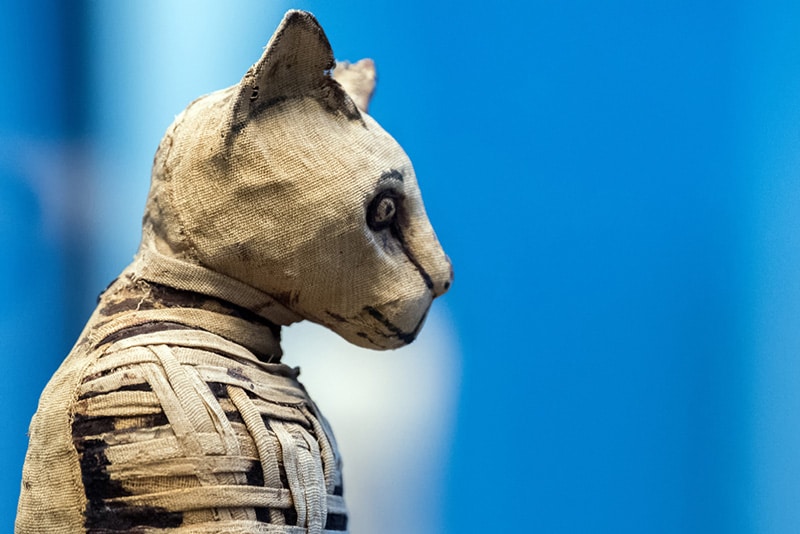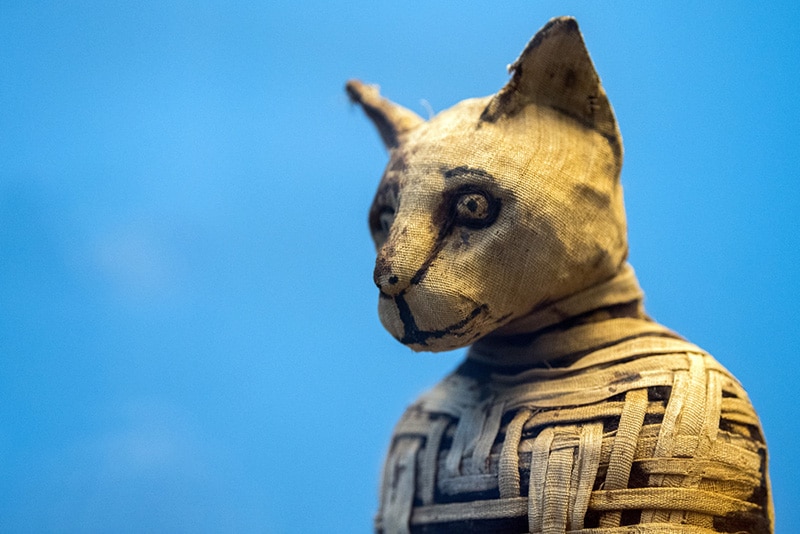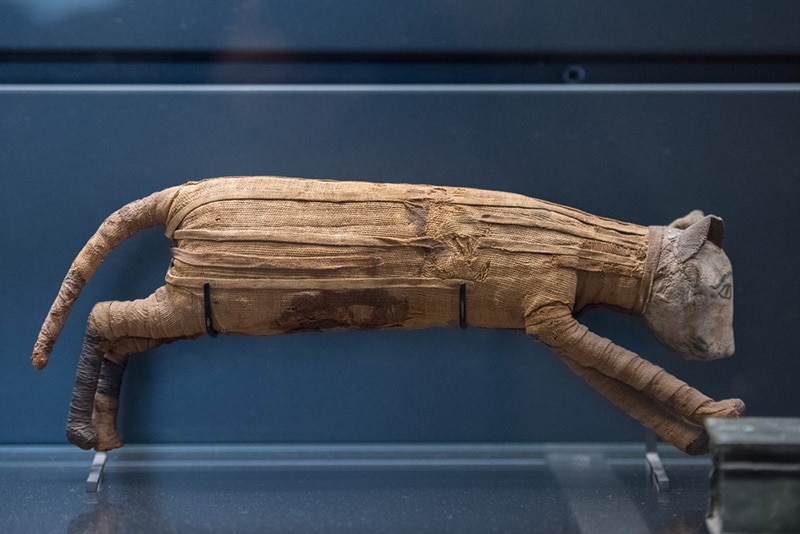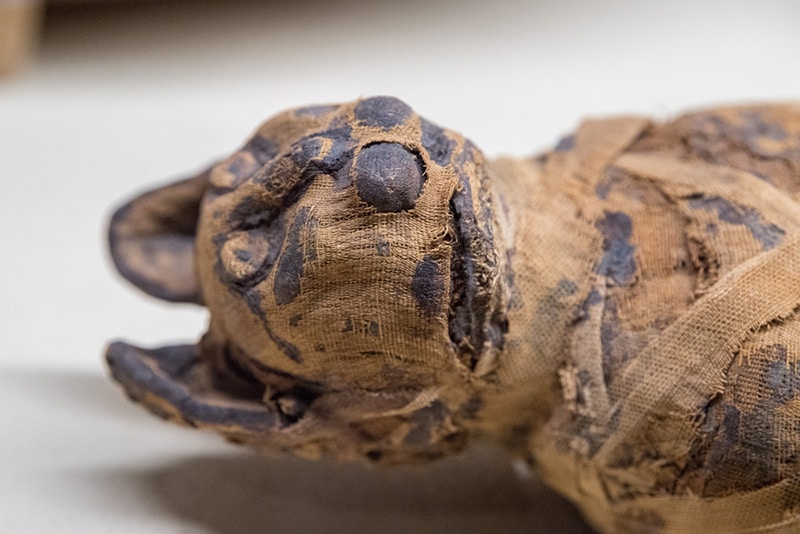Although hilarious cat videos are relatively new, cat lovers have existed for a long time. As you may know, the ancient Egyptians considered cats sacred animals. Some were kept as pets, while others were dedicated to the cat goddess Bastet. But did you know that several cats were mummified?
In this article, we’ll take a deep dive into the history of cat mummies and talk about where they are today.
History of Cat Mummies
Experts say that cats can be seen in Egypt’s archeological record as far back as 5,000 years ago. The love the ancient Egyptians had for cats is well-documented, and cats became highly entwined with their day-to-day life. Cats were used as rat catchers, protectors against snakes, and bird hunters.
Like today, cats were even brought into households as beloved pets. It is believed that killing a cat may have been a punishable offense in Egypt. But why were cats treated with such esteem? Experts think cats earned their reputation over time due to their grace and usefulness.
The cat’s affinity for napping in the sun also gave them a connection to the sun god, Ra, but their strongest spiritual connection was to the goddess Bastet, who was depicted as a domestic cat. Bastet was the goddess of protection, fertility, and birth.
In the 5th century B.C.E., the city of Bubastis developed a massive following of Bastet–and, by association, cats. Here, devoted followers of Bastet would offer cat statues to the goddess and wear cat amulets for protection.
The cat held significant importance in ancient Egypt, whether for practical or spiritual purposes. Some cats were important enough to be interred alongside their owners. This was not the only case in which cats were mummified, however.
In 2018, a 4,500-year-old tomb was discovered on the outskirts of Cairo. The tomb was filled with dozens of cat statues and mummified cats. Cat cemeteries such as this one became widespread around 1000 B.C.E. The cats in these tombs were carefully wrapped and decorated, showing the ancient Egyptians’ reverence for them.
Cat mummies were discovered long before the modern day. In the 1890s, thousands of cat mummies were discovered in an archeological excavation. The mummies were found so abundant that some experts believe that there were cats bred to be mummified and given as offerings. To get an idea of just how many mummified cats these archeologists found, one cargo shipment sent 180,000 of them to England.

How Were Cats Mummified?
The process of mummification is not fully known since the ancient Egyptians didn’t record their techniques. However, we can find clues in ancient writings and modern science. Herodotus, the Greek geographer and historian, briefly references a feline embalming process.
He described how deceased cats were taken to sacred buildings in the city of Bubastis for enablement and burial. Another Greek historian, Diodorus Siculus, recorded vague stages of the process. He noted that deceased felines were wrapped in fine linen before being embalmed.
Afterward, the embalmed cat would be treated with spices and cedar oil to preserve the body and give it a pleasant odor. With a modern understanding of science, experts believe that cats may have been embalmed by softening their bodies in sodium carbonate and sodium bicarbonate rather than trying to preserve them fully.
The skeleton could then be easily removed, wrapped in linens, and buried. Regardless of the process, the cat’s wrapped body would be decorated to resemble a cat. Sculpted heads or masks were often used to make the mummy’s head resemble the shape of a cat’s head.

Where Are Cat Mummies Now?
Cat mummies have been found in abundance, from the excavation in the 1890s to the more recent findings in 2018. Though many have been found, they aren’t always displayed in museums.
In 2017, one was displayed at the Smithsonian’s Arthur M. Sackler Gallery in an exhibition called “Divine Felines: Cats of Ancient Egypt.” The mummy belongs to the National Museum of Natural History and is wrapped in linen with feline facial features painted in black ink.
There is also a cat mummy that belongs to the British Museum. It was exhibited from 1986–1996 in various museums across the world. This mummy is wrapped in patterned linens and given coarse linen buttons for eyes.
Although many thousands of cat mummies have been uncovered, it is possible that there are still more to find. Some experts estimate that as many as a million cats were mummified, and it is likely that there are still more to find.

Interesting Facts
- Although cats were considered sacred, they weren’t all deities. A cat would become a deity if a sacred ritual were performed or the goddess Bastet was believed to reside within the animal.
- It is believed that special fur patterns and markings made a cat divine compared to others.
- If someone killed a cat, intentionally or not, they could be punished.
- Even if the ancient Egyptians suffered extreme famine, they were not permitted to kill and eat cats.
- Mummified cats were often dedicated to Bastet to gain her favor.
- Some experts believe that cats were bred and killed for the purposes of mummification.

Final Thoughts
While the concept of cat mummies may seem morbid to some, the fact that so many have been well-preserved and discovered suggests that cats were highly revered in ancient Egyptian society. The connection between cats and the Egyptians has spanned thousands of years, making it a special one. Hopefully, in 5,000 years, archeologists will know how much our cats mean to us.
See also:
- Are Tapeworms in Cats Contagious? Vet-Reviewed Health Facts
- How to Clean Tough Messes from Your Cat’s Fur: Vet-Approved Guide
Featured Image Credit: Andrea Izzotti, Shutterstock








